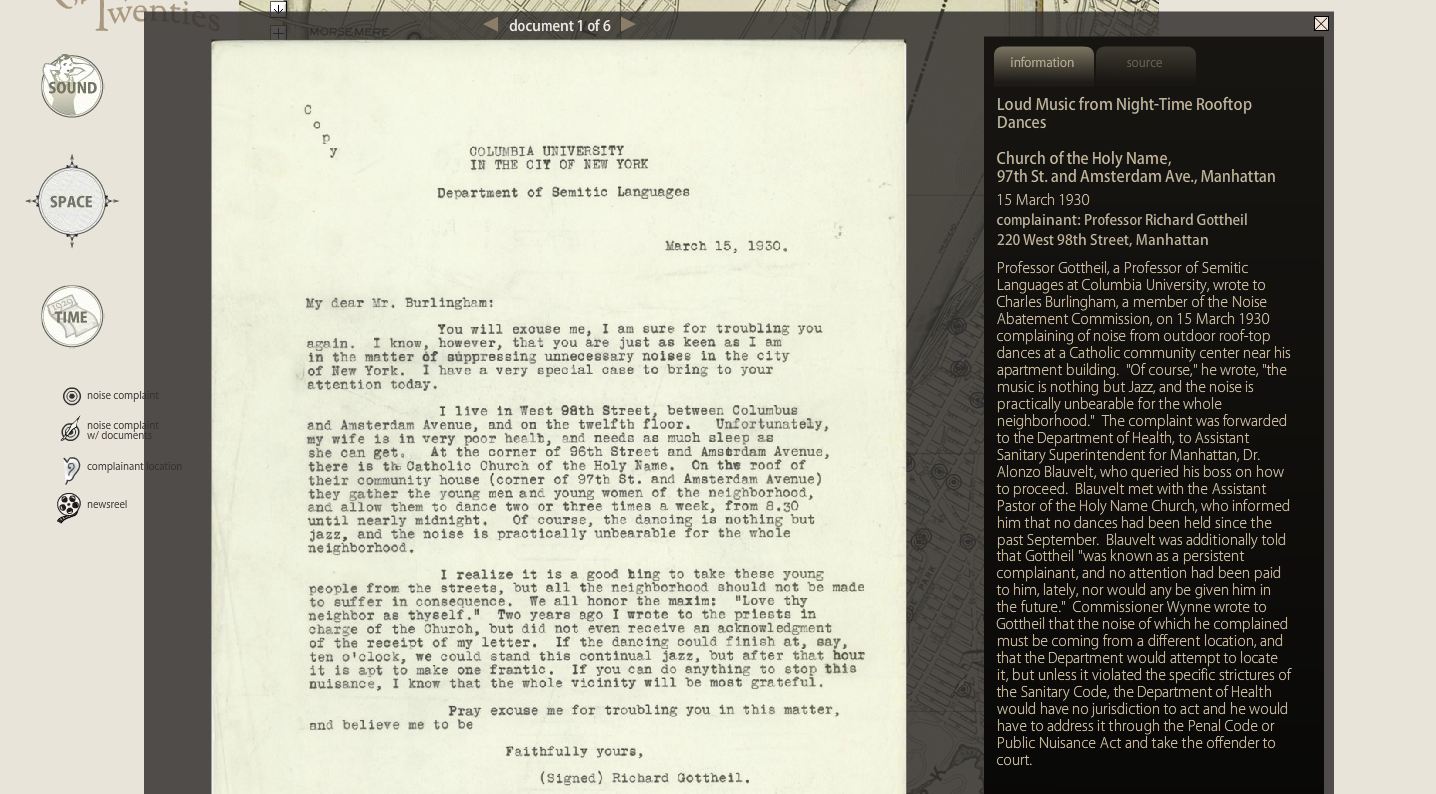The Roaring Twenties
an interactive exploration of the historical soundscape of New York City
By Emily Thompson
Design by Scott Mahoy
Its data is mined through the time-honored techniques of the historian in the archive, through human filtering and detailed close readings.
- Tara McPherson, Editor's Introduction
Alternative views of The Roaring Twenties project data:
 All info and conversations from this project page
All info and conversations from this project page
http://vectors.usc.edu/xml/projects/theroaringtwenties_v1.xml
 RSS feed of the conversations from this project page
RSS feed of the conversations from this project page
http://vectors.usc.edu/rss/project.rss.php?project=98
http://vectors.usc.edu/xml/projects/theroaringtwenties_v1.xml
http://vectors.usc.edu/rss/project.rss.php?project=98
Author Statement
Many years ago I published a book about sound and architecture called The Soundscape of Modernity. The book is a history of the intersection of the evanescent and the concrete. Throughout its narrative, the ephemeral vibrations of sound interact with a material world intended to control those vibrations. When I wrote Soundscape, I was interested in historicizing the act of listening as much as the things people heard or the tools they deployed to hear those things. One of the points I hoped to emphasize was the newness of the idea, as well as the technological reality, of sound separated from the material space in which it was created. Both the idea and its realization were the fruition of a distinctly modern way of thinking about sound, space, and technology that culminated in the early twentieth century.When the book first appeared in 2002, I was often asked why I didn't issue a companion CD filled with audio recordings of the sounds of the spaces I wrote about, including Symphony Hall in Boston, and St. Thomas's Church and Radio City Music Hall in New York City. While I hope I always responded politely, in fact, the question kind of annoyed me. I felt that it missed the whole point of the book, which was to historicize - and thus not to take for granted - the idea that the sound of a specific place could be technologically captured, dislocated from its origins and relocated somewhere else, for example onto a compact disc and hence into any listener's living room (which was primarily where one listened to CD audio recordings way back in 2002).
Now, all these years later, I find myself doing the very thing that I resisted when my book was published, but with the benefit of a technology far more powerful than compact discs at transcending the traditional connections between sound and place. In the past decade, the meaning of space - actual, physical, inhabitable space - has been so fully upended by a culture built upon interconnected technologies of data distribution that the material embodiment of sound etched onto the discrete surface of a compact disc now seems as ancient a relic as the neo-Gothic statuary within St. Thomas's Church. People today listen to recorded sound anywhere and everywhere, and many engage in modes of listening that not only dissociate the sounds they hear from their places of origin, but also render themselves oblivious to the spaces in which they are physically located while they listen. The time now seems ripe to deploy these technological tools in a different direction; to use the distribution, organization, and presentation of data to reinvoke a sense of the very specific historical times and physical places in which the sounds of the past were embedded.
By offering a website dedicated to the sounds of New York City circa 1930, The Roaring 'Twenties is following the lead of countless other individuals and organizations who have turned the web into a vast sonic archive, delivering a previously unimaginable wealth of historic sound recordings to anyone with a connection and a desire to listen in. With The Roaring 'Twenties, I hope we not only add to that archive, but also set an example by doing so in an explicitly historically-minded way. The aim here is not just to present sonic content, but to evoke the original contexts of those sounds, to help us better understand that context as well as the sounds themselves. The goal is to recover the meaning of sound, to undertake a historicized mode of listening that tunes our modern ears to the pitch of the past. Simply clicking a "play" button will not do.
How our website attempts to achieve this goal is outlined more fully in the Introduction built into the site itself. In this more personal set-up, I want instead to elaborate briefly upon a second goal, one that addresses - perhaps appropriately for a website about listening - the issue of audience. In constructing The Roaring 'Twenties, we consciously kept multiple audiences in mind and we aimed to speak to a range of different groups through our design. The audiences we imagined range from the scholarly to the general: from academics currently engaged with investigations in sound studies, sensory history, and urban history; to students of all ages; to members of the general public who perhaps live in, grew up in, or are simply interested in, the neighborhoods of New York. If we have done our job well and taken full advantage of the generous opportunity that the Vectors' editors provided, the history buff as well as the history professor should find meaning in the site and its content should stimulate personal responses as readily as it does more intellectually objective inquiries. If our ambitions have exceeded our accomplishments, perhaps the site can serve as a lesson for others, to help them realize more fully the rich potential of the web for public history and sensory history.
— Emily Thompson, June 23rd, 2021


